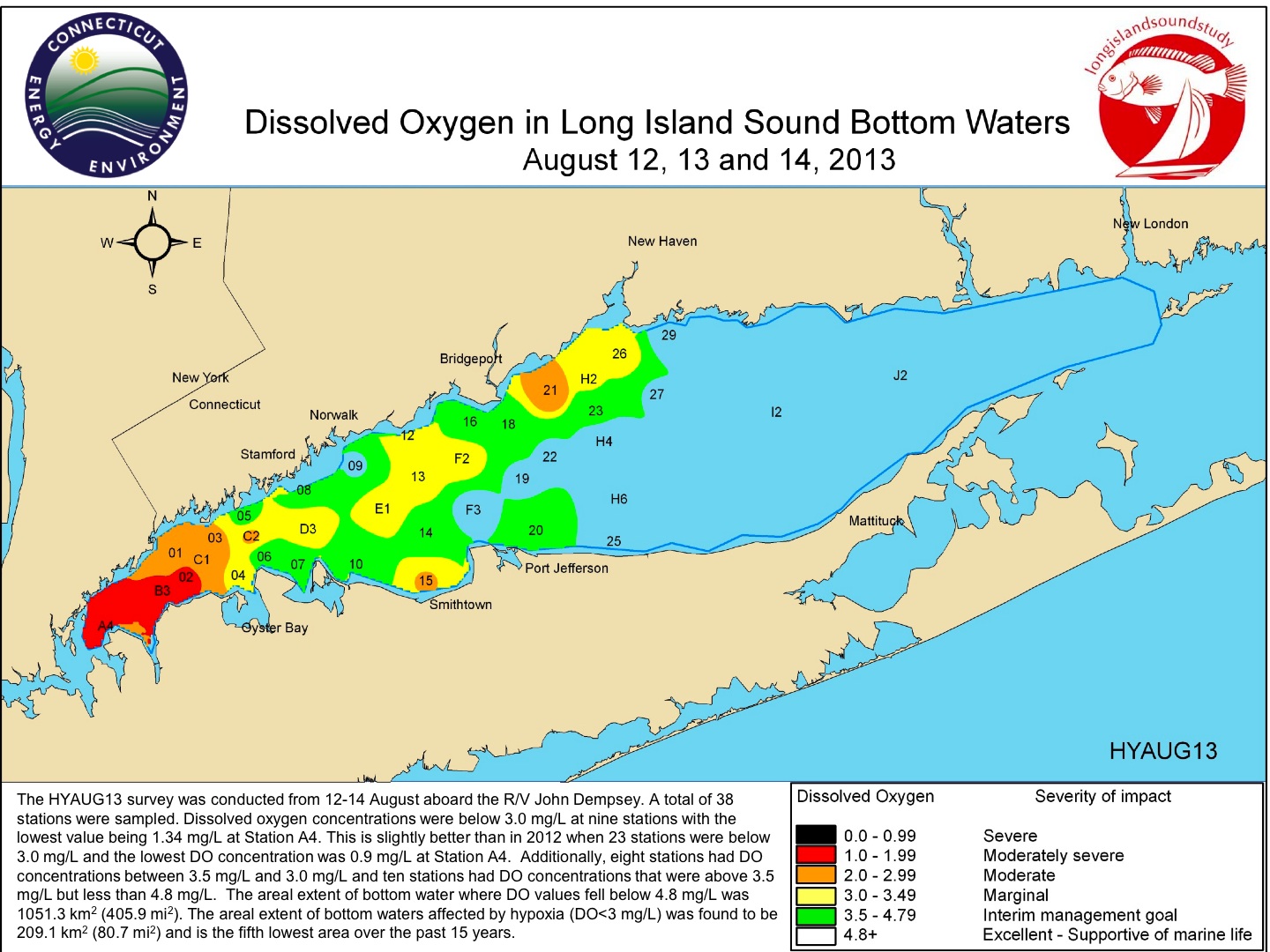The results are in: compared to last year, the summer of 2013 on Long Island Sound wasn’t so bad for marine life. Water quality as measured by dissolved oxygen improved over the dismal conditions in 2012 and only a relatively small area saw drastically low dissolved readings.
Unfortunately if you happen to be a human or aquatic resident of Westchester or Nassau counties, that relatively small area is where you live.
Low dissolved oxygen, or hypoxia, is considered to be the Sound’s most critical ecological issue. When oxygen falls, large areas of the Sound’s bottom waters lose their ability to harbor healthy populations of fish, crustaceans, mollusks and other estuarine life. In fact, as oxygen drops, there is a measurable loss of fish biomass (the total weight of fish, which biologists catch and weigh during research trawls). Here’s what happens:
Marginal hypoxia: Below 4 mg/l – 4 percent reduction in fish biomass
Moderate hypoxia: Below 3 mg/l – 41 percent reduction
Moderately severe hypoxia: Below 2 mg/l – 82 percent reduction
Severe hypoxia: Below 1 mg/l – 100 percent reduction (virtually no fish caught)
A season-ending hypoxia review released last week by the Connecticut Department of Energy and Environmental Protection reported that in 2013 the hardest hit area was, as usual, the far western end of the Sound, where oxygen readings fell below 2 milligrams per liter – moderately severe hypoxia – over 33 square miles. That was bad but it still marked an improvement over 2013 and was considerably better than average: in 2012, 67 square miles suffered from moderately severe hypoxia, while the average for the 23 years the DEEP has been keeping records is 62 square miles.
 In 2013, about 81 square miles – roughly 6 percent of the Sound’s 1,300 square miles – were hit with moderate hypoxia (below 3 milligrams per liter). That’s far better than 2012, when moderate hypoxia hit 288 square miles (22 percent of the Sound). It’s also better than the 23-year-average of 179 square miles. This map, prepared by the DEEP, shows hypoxia at its 2013 worst, in mid-August (click it to make it bigger).
In 2013, about 81 square miles – roughly 6 percent of the Sound’s 1,300 square miles – were hit with moderate hypoxia (below 3 milligrams per liter). That’s far better than 2012, when moderate hypoxia hit 288 square miles (22 percent of the Sound). It’s also better than the 23-year-average of 179 square miles. This map, prepared by the DEEP, shows hypoxia at its 2013 worst, in mid-August (click it to make it bigger).
In 2013, dissolved oxygen was below 3 for 62 days, about the same as last year. The 23-year average is 55 days.
The best news is that none of the Sound experienced severe hypoxia, or dissolved oxygen below 1 mg/l, this year. Last year 18 square miles were affected, and the 23-year average is 13.5 square miles. In the last 23 years, there have been only 10 summers when the whole Sound stayed above 1.
The key cause of the oxygen drop is the massive amount of nitrogen released into the Sound by sewage treatment plants. Nitrogen fertilizes algae; when the algae die, their decomposition removes oxygen from the water, which forces fish, lobsters, crabs and other marine life to flee. Those that can’t get out fast enough may die or suffer stresses that make them more susceptible to illness and less likely to reproduce.
Officials have been tracking dissolved oxygen numbers for decades as part of a state and federal effort to end hypoxia. Essential to that effort are upgrades at sewage treatment plants, with a goal of cutting nitrogen output by 58.5 percent by 2014 for Connecticut plants and 2017 for plants in New York.
Connecticut is making good progress, but New York City and Westchester, Nassau and Suffolk counties have substantial work ahead. And even when the 58.5 percent goal is reached, scientists estimate that there will be a lag of five to 10 years before we see conditions rebound completely (there’s more in our post from April).
Save the Sound is advocating for federal and state funding so municipalities can make the necessary investments. This past spring, Connecticut allocated nearly $1 billion over the next two years for the state’s Clean Water Fund. We’ve also taken the Great Neck Water Pollution Control District and the New York State Department of Environmental Conservation to court to help ensure that treatment plants meet their mandatory deadlines for upgrades.
We urge New York residents to let their state elected officials know that they support increased funding for clean water, and to ask their local leaders to make sewage treatment upgrades a priority.
– Tom Andersen, New York program and communications coordinator, Save the Sound

1 thought on “2013 Water Quality: Improved But Still Not Great Off Westchester and Nassau”
Comments are closed.